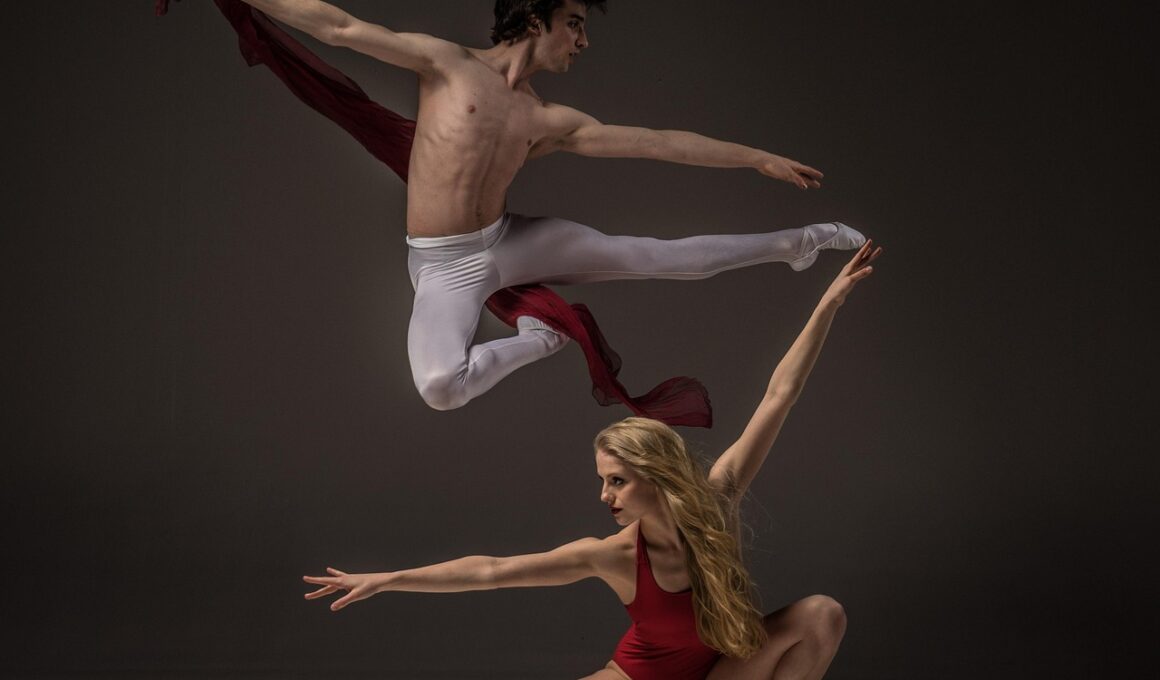Stretching Myths in the Context of High-Intensity Interval Training
High-Intensity Interval Training (HIIT) has gained immense popularity due to its effective and efficient workout style. However, there are several myths surrounding stretching in the context of HIIT that need clarification. One prevalent myth is that stretching before a HIIT session can prevent injuries. Research shows that static stretching may actually reduce performance temporarily and does not significantly prevent injuries. Instead, a proper warm-up is recommended to prepare your muscles for high-intensity efforts. Active movements that raise heart rate prepare your body better for the subsequent workout. Moreover, it is crucial to address the difference between static and dynamic stretching. While static stretches involve holding a position, dynamic stretches incorporate movement, making them more suitable during HIIT warm-up. Dynamic stretches increase blood flow to your muscles, enhancing flexibility without risking injury. Therefore, it’s essential to embrace dynamic movements before engaging in HIIT. Understanding these aspects and debunking myths will ultimately enhance your workout routine and improve overall performance while ensuring safety during high-intensity training.
Another common myth surrounding stretching and HIIT is that it is beneficial to stretch right after a workout instead of during workouts. While post-workout stretching can help enhance flexibility, it is crucial to incorporate stretching at various intervals during HIIT workouts. Stretching during your HIIT routine can improve range of motion and is particularly beneficial as you transition between different exercise modalities. For instance, engaging in stretches between intervals allows your muscles to recover slightly while preparing them for the next explosive effort. Also, maintaining flexibility helps prevent muscular imbalances, enhancing performance in the long run. It is advisable to include sport-specific stretches relevant to the movements being performed. These movements can include lunges, arm circles, or torso twists that activate the muscles you engaged in your intervals. Furthermore, stretching during HIIT workouts helps to keep the heart rate elevated, ensuring you stay in your target activity level. Therefore, understanding the significance of incorporating stretching throughout your HIIT sessions is vital for maximizing efficiency and effectiveness in your training endeavors.
The Importance of Flexibility in HIIT
Flexibility is often overlooked but plays a crucial role during HIIT. Poor flexibility can prevent optimal performance in HIIT workouts, making flexibility a valuable asset for those looking to achieve peak physical condition. When participating in high-intensity exercises, your muscle fibers experience rapid contractions, requiring an adequate range of motion to maintain efficiency. Limited flexibility can restrict this range, leading to decreased performance and possibly injury. Incorporating targeted stretching exercises will ultimately improve flexibility and, in turn, performance during HIIT. This can establish a better foundation for executing techniques in various movements, such as squats or jumps, that involve explosive actions. Moreover, by engaging in a consistent flexibility routine, individuals foster muscle balance, allowing for smoother transitions between workouts and promoting recovery overall. Regular stretching helps in lengthening the muscle fibers, relieving tightness, and reducing post-workout soreness. This enhancement of muscle elasticity is crucial for HIIT participants who often pursue different movement patterns quickly. Prioritizing flexibility in HIIT routines ultimately contributes to a more effective and safer training approach.
One common misconception is that stretching sessions are time-consuming and should be avoided during HIIT training. However, flexibility-focused routines can be quick and effective, requiring only a few minutes of dedicated time before or between intervals. Including short, dynamic stretches as a part of your HIIT routine is an excellent method to ensure flexibility gains without compromising workout intensity. Fifteen minutes of targeted stretches can make a substantial difference over time. Adapting a warm-up sequence that incorporates flexibility movements can be seamlessly integrated into your HIIT approach. Additionally, utilizing effective tools such as resistance bands or foam rollers during active stretches can further enhance flexibility. These tools not only improve range of motion, but they also aid in muscle activation, increasing overall effectiveness. Moreover, the improved flexibility attained from dedicated stretching sessions can yield better performance during workouts and longer-term muscle health. Remember, developing an efficient HIIT routine does not neglect the importance of flexibility and learning how to incorporate it strategically can elevate training goals.
Stretch & Recovery Techniques
Incorporating effective stretching techniques into your routine can vastly improve recovery times post HIIT sessions. Foam rolling is an exceptional method that aids in breaking down muscle knots and enhancing circulation, further facilitating recovery. This technique can be executed immediately after a workout to alleviate soreness and promote relaxation within the muscles. Combining foam rolling with stretching can create a comprehensive recovery plan without taking too much time. Static stretches performed after your HIIT sessions will also help in increasing muscle length and relieving tightness effectively. Targeting major muscle groups involved during HIIT can ensure that these areas receive attention necessary for quick recovery. Furthermore, incorporating mobility drills that focus on joint movement will assure that flexibility is not only developed but maintained. Implementing such routines post-workout enhances muscle relaxation while minimizing the risk of future injuries. Thus, understanding and applying more diverse stretching and recovery techniques tailored to your HIIT sessions results not only in better performance but also longevity in your fitness journey. The synergy of stretching, foam rolling, and recovery exercises can create a holistic approach to HIIT.
Incorporating breathing techniques alongside stretching can take your HIIT routine to another level of effectiveness. Deep breathing helps activate your parasympathetic nervous system, promoting relaxation and optimal performance. Also, employing controlled breathing patterns throughout your stretching routine enhances mobility and muscle flexibility. When paired with movements, synchronized breathing aids in lengthening and decompressing the muscles, allowing for deeper stretches and improved range of motion. By consciously practicing deep belly breathing—where one inhales through the nose and exhales through the mouth—you increase oxygen flow to your muscles. This process is paramount for energy production and stamina during high-intensity workouts. Moreover, oxygenated muscles recover faster, contributing to overall performance during HIIT training. Integrating specific breathing patterns into your stretches will create a rhythm, enhancing engagement in your workout session. Therefore, breathing techniques should not be neglected when planning your HIIT routine. Understanding the relationship between breath and movement will foster not only physical readiness but also mental focus, culminating in a more fruitful training experience overall.
Final Thoughts on HIIT and Stretching
In conclusion, stretching is far from a mere formality in the context of HIIT; rather, it holds the potential to optimize performance and prevent injury if integrated correctly. Instead of adhering to outdated myths, individuals should aim to actively incorporate flexibility into their workout routines. Understanding the difference between static and dynamic stretching, while tailoring strategies to fit within HIIT sessions, is essential. The misconceptions about stretching being unnecessary or a waste of time can hinder progress. Conversely, recognizing the value of flexibility, well-structured recovery techniques, and effective breathing patterns can lead to substantial gains, both physically and mentally. HIIT enthusiasts are encouraged to embrace a holistic workout strategy that includes stretching throughout training. Ultimately, a commitment to addressing stretching seriously will yield improved strength, endurance, mobility, and recovery speed. Those dedicated to HIIT should not overlook these crucial components, as they can significantly impact one’s fitness journey. Following these guidelines can propel you towards achieving measurable gains, ensuring a more enjoyable and rewarding high-intensity training experience in the long term.
In summary, debunking myths around stretching in HIIT settings contributes significantly to better training practices. By gaining insight into effective stretching techniques, HIIT participants can ensure they maximize workout efficiency and maintain good health. Embracing effective practices supports athletes at every performance level. Adequately incorporating flexibility-focused routines into exercise schedules will maintain motivation and a sense of accomplishment. Exploring the effects of stretching can open new avenues for personal growth and peak physical condition. Remember, prioritizing flexibility helps establish overall balance, further guiding your athletic journey towards success. The knowledge of integrating stretching approaches into HIIT routines is a powerful tool for any fitness enthusiast striving for improvement. Maintaining a commitment to these practices will cultivate not only physical attributes but also mental clarity. As you navigate through your high-intensity training, blending breathing techniques and effective warm-up methodologies guarantees excellent results. Ultimately, education regarding stretching in HIIT should evolve to enhance training regimens as a whole. By adopting a more comprehensive approach towards flexibility, participants can truly experience endless possibilities in their fitness journeys.


